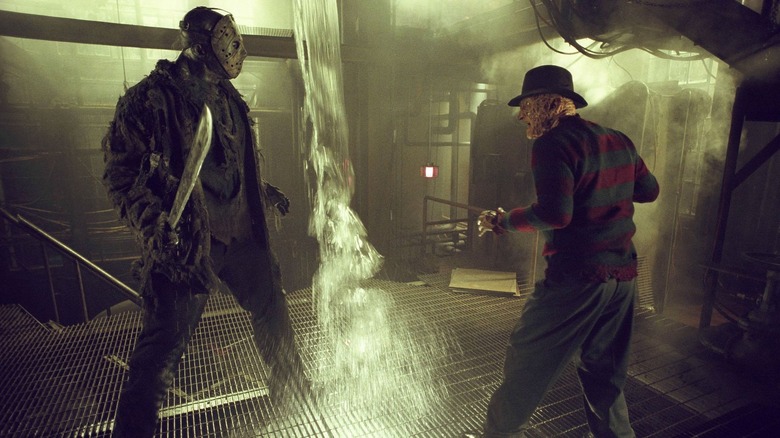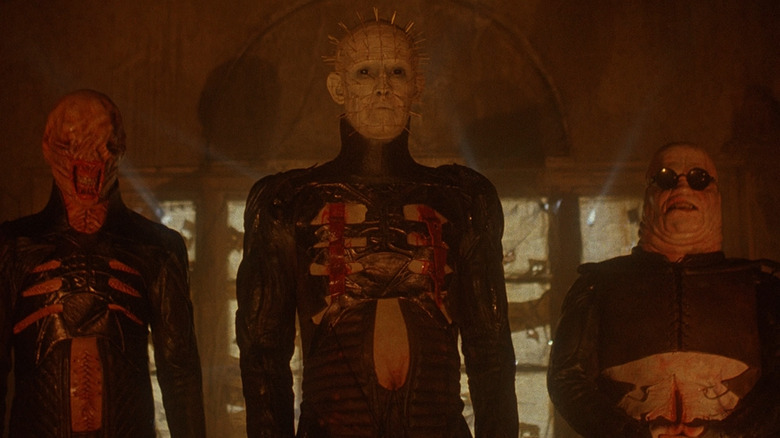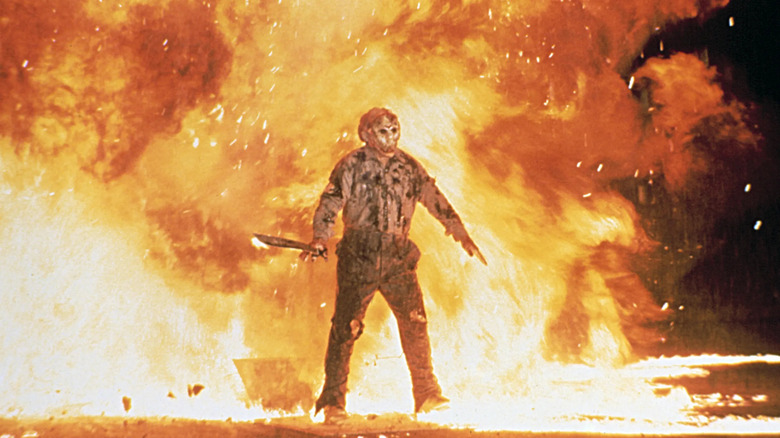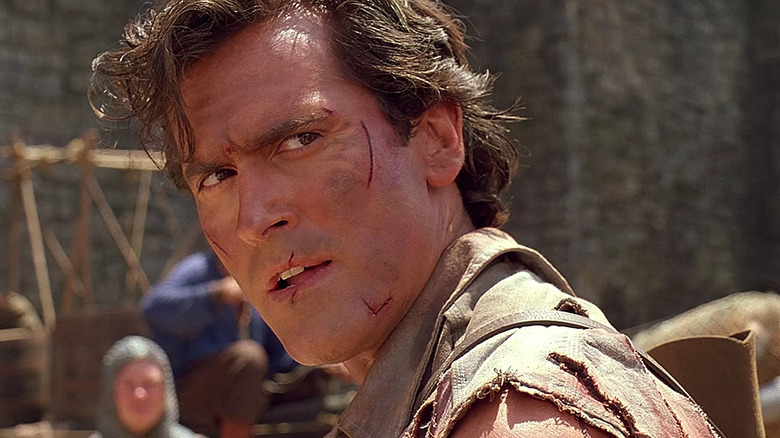Freddy Vs Jason's Original Ending Set Up A Sequel We Never Saw
Ronnie Yu's 2003 film "Freddy vs. Jason" — simultaneously the eighth film in the "Nightmare on Elm Street" series and the eleventh film in the "Friday the 13th" series — finally brought together two of the most popular characters of the 1980s slasher boom and had them wail on each other in a series of supernatural monster fights. Most slasher fans would have appreciated a "Freddy vs. Jason" film about a decade earlier, but there was still magic in the air in 2003; Yu's film made over $116 million on a $30 million budget.
It also, in a very utilitarian way, gave audiences exactly what they wanted. There was a decent-enough retinue of teenage victims to slaughter (led by actress Monica Keena). The story hung together juuuust well enough. And the final fights between Freddy (Robert Englund) and Jason (Ken Kirzinger) addressed any late-night, heavily intoxicated concerns horror fanboys might have posited. Who would win in a fight? If Freddy and Jason were in the dream world, Freddy would have the upper hand. If, however, Freddy were dragged into the real world of Camp Crystal Lake, the dream demon wouldn't stand a chance against the living campfire story. The fight venues change rapidly, the monsters cut each other up pretty badly, and there is a clear victor.
Or is there? As Jason exits the scene carrying Freddy's severed head, Freddy perks up and winks at the camera. Evil never dies. Hooray.
As one might assume, several other possible endings were floated before landing on the one the "FvJ" filmmakers did. Indeed, according to a 2016 article in Bloody Disgusting, screenwriters Mark Swift and Damian Shannon originally planned that horror titans should die, go to Hell, and fight in the presence of Pinhead from the "Hellraiser" film series.
Freddy and Jason Go to Hell
The mythology of Clive Barker's 1987 film "Hellraiser" is actually a lot more complex than the simple Christian version of Hell frequently seen in popular media. In Barker's vision, Hell is a realm of extreme sensory/sensual overload wherein elaborately mutilated S&M doms — called Cenobites — used meathooks to rip apart their victims ... providing them with the ultimate sexual experience. Pain and pleasure are indivisible for them. The lead Cenobite from "Hellraiser" was eventually nicknamed Pinhead (Doug Bradley) for the nails evenly driven into his skull and face. By 2003, it seemed that the "Hellraiser" films had also come to an end, with the fourth, "Hellraiser: Bloodline," having come out in 1996.
Placing Freddy and Jason in Hell made logical sense, as it locked in with a fun stinger included at the end of Adam Marcus' 1993 film "Jason Goes to Hell: The Final Friday." That film concluded with the destruction of Jason Voorhees (Kane Hodder) and his subsequent descent into Tartarus. Jason's mask is left behind. Then, unexpectedly, Freddy's famous razer-fingered glove bursts out of the dirt, grabs the mask, and drags it below. Two years prior, Rachel Talalay directed "Freddy's Dead: The Final Nightmare," so both monsters were now dead, available to have a coffee klatch in Hell. And who else should be waiting there but Pinhead, eager to torture them both? It would be a meetup for the ages.
According to Swift and Shannon, the executives at New Line Cinema loved the idea, and would have happily had a "Hellraiser"-adjacent stinger, but didn't know how they would acquire the film rights to the Pinhead character. New Line already owned both Freddy and Jason. The film rights to "Hellraiser" still lived with Miramax at the time.
The Hell story
Of course, even getting Freddy and Jason into Hell was a matter of some debate. Do they die and simply manifest there? One of the "FvJ" screenwriters (unspecified in the Bloody Disgusting article) recalls the many, many drafts he and his partner wrote. He said:
"How they got to Hell was something that changed probably a dozen times. In one version, the lake drained, leaving only Freddy's severed glove at the bottom of the dry lake. Will goes to pick it up, and he gets yanked down. Another: Ronny [Yu] had an idea about a giant hand rising up out of the lake and pulling Freddy and Jason down. We tried all kinds of things; we wrote a ton of drafts for this movie."
It seems that the "Hellraiser" ending was ultimately abandoned not only because New Line couldn't get the rights, but because no one had a good enough idea as to how to envision Hell. The final film, then, was entirely earthbound or set in the dream dimension. The screenwriters commented:
"[I]n the end, we lost the idea of Hell altogether. The studio said something that stuck with us, and that's 'Hell never looks good onscreen.' They're probably right about that. Hell is more powerful in our imagination. When you try to actually shoot it, nine times out of ten it looks cheesy. So we have no regrets about not ending up in Hell."
So "Freddy vs. Jason vs. Pinhead" would never be made. "Hellraiser" shifted to straight-to-video sequels, and Freddy and Jason experienced latter-day remakes.
There was, however, a different "FvJ" sequel that was very briefly in pre-production. Horror fans can likely tell you all about the legend of "Freddy vs. Jason vs. Ash," a crossover with Sam Raimi's "Evil Dead" movies.
Freddy vs. Jason vs. Ash
Note: while fans may have wanted Michael Myers from "Halloween" involved in a monstrous battle royale, including him in a script was never anything more than conjecture.
Unlike a "Hellraiser" crossover, a treatment for "Freddy vs. Jason vs. Ash" was actually written in full. According to a different article in Bloody Disgusting, New Line Cinema executive Jeff Katz wrote a story wherein Ash (Bruce Campbell), usually wrapped up in the slapstick violence of nondescript demons called Deadites, was to fight both Freddy Krueger and Jason Voorhees, killing off Freddy once and for all. Resourceful internet hunters can find the treatment online. Ash, to remind readers, was a comedically a-hole-ish antihero who would most certainly live through a monster fight, wielding a chainsaw affixed to the stump where his right hand used to be. Ash wouldn't "win," however, as he is incredibly unlucky; Katz wondered in his treatment if Ash should be unwittingly sucked into an alternate dimension at the end of "FvJvA."
The connection between "Evil Dead" and "Friday the 13th" or "A Nightmare on Elm Street" seems tentative, until fans of "Jason Goes to Hell" recall that the Necronomicon, the book of unspeakable evil from Raimi's films, made a cute Easter egg-style cameo in the 1993 film. Katz took that cameo quite literally. Horror fans would do well to read Katz's treatment, as it's quite a hoot. The film itself was never actually put into production, however, and eventually was transformed into a six-issue comic book series, published in 2007 and 2008. The comics merely extrapolate the original idea, expanding them a little bit. The next year, "Nightmare Warriors" was also published. That one was wholly original.
Even without the unmade sequels, though, "Freddy vs. Jason" is a fun, fan-service film for the ages.



